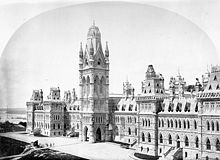Naval Aid Bill
| Naval Aid Bill | |
|---|---|
 Parliament of Canada buildings in 1913 | |
| Parliament of Canada | |
| |
| Citation | Bill 21, 12th Parliament, 2nd Session |
| Enacted by | House of Commons of Canada |
| Considered by | Senate of Canada |
| Legislative history | |
| First chamber: House of Commons of Canada | |
| Introduced by | Sir Robert Borden |
| First reading | December 5, 1912 |
| Second reading | February 18 to 28, 1913 |
| Committee of the whole | February 28 to May 10, 1913 |
| Third reading | May 15, 1913 |
| Second chamber: Senate of Canada | |
| Member(s) in charge | James Alexander Lougheed |
| First reading | May 20, 1913 |
| Second reading | Defeated May 29, 1913 |
| Related legislation | |
| Naval Service Act | |
| Summary | |
| Bill to provide financial contribution to the British Royal Navy | |
| Status: Not passed | |
The Naval Aid Bill was a bill introduced in the House of Commons of Canada, by Conservative Prime Minister Robert Borden on December 5, 1912. The bill proposed that the Canadian government spend $35,000,000 to build battleships or armoured cruisers, which Canada would make available to the British Royal Navy if needed for defence of the British Empire. Although the bill passed the Canadian House of Commons, where Borden had a majority government, it was defeated in the Senate, which had a Liberal majority.
Background
The 1911 federal election, in which the Conservatives defeated the Liberal government, was fought largely on the question of what role Canada should play in the common defence of the British Empire. At the time, Britain was engaged in a naval arms race with the German Empire. While the Liberals and Conservatives both agreed that the best long-term maritime defence policy would be for Canada to acquire its own navy, the Conservatives vehemently objected to Liberal Prime Minister Wilfrid Laurier’s Naval Service Act, which called for construction of that fleet to begin immediately. As Opposition Leader, Borden argued that Laurier’s plan to operate an autonomous fleet of five cruisers and six destroyers was a wholly inadequate response to the Empire's apparently pressing need.
What was not yet well known within Britain or Canada was that by 1912 the German government had quietly scaled back its naval ambitions in favour of strengthening its army. The Germans had made this policy change in secret, and in any event the Admiralty strenuously downplayed reports that the Germans might have been giving up on their attempt to surpass the Royal Navy. As the new Prime Minister of Canada, Borden visited the United Kingdom in 1912 to accept the knighthood that was customarily granted at the time to Dominion Prime Ministers. While in the U.K., at the urging of the First Lord of the Admiralty Winston Churchill, Prime Minister Borden agreed to finance the construction of three dreadnoughts for $35 million.[1]
Debates in Parliament
The Conservative plan was at least three times more costly than the Liberal plan to construct a Canadian-operated fleet, and would reap no benefits to Canadian industries whatsoever.[citation needed] On December 5, 1912, Borden introduced the Naval Aid Bill in the House of Commons as a one-time contribution to Britain's navy.[2]
The bill was short, only five sections long. It authorised the Canadian government to spend up to $35,000,000 for "the construction and equipment of battleships or armoured cruisers of the most modern and powerful type".[3] Once completed, Canada would place them at the disposal of the King, "for the common defence of the Empire",[4], on terms to be concluded between the Government of Canada and the British Government.[5]
After a bitter debate and a long filibuster by the opposition Liberals, the Borden government invoked closure on the debate, for the first time ever in Canadian Parliament, on May 15, 1913. The Act was soundly defeated by the Liberal-majority Senate two weeks later.
Aftermath
Had the bill passed the Senate and received Royal Assent, it is likely the funds would have been used to construct three Queen Elizabeth-class battleships, potentially named as Acadia, Quebec and Ontario.[6] The bill's failure ultimately made little impact on the naval arms race. The First World War commenced about fourteen months after the bill's defeat. At the time, none of the five Queen Elizabeth class battleships that were ultimately built for the Royal Navy had yet been commissioned.
At the start of the war, Britain had 22 dreadnoughts in service compared to Germany's 15, but Britain also had 13 dreadnoughts under construction even without a Canadian contribution, and by then, the Germans were building only five additional dreadnoughts. With the additional naval strength of France in the Atlantic and Japan in the Pacific, later bolstered by the entry of Italy and eventually the United States, Allied control of the high seas was never seriously threatened and Germany was compelled to seek less costly alternatives (submarines in particular) to project a measure of power in the Atlantic sea lanes.
Notes
- ^ German 1990, p. 29.
- ^ Journal of the House of Commons, vol. 48 (12th Parliament, 2nd Session, December 5, 1912), p. 54.
- ^ Senate and House of Commons Bills (12th Parliament, 2nd Session), Bill 21: The Naval Aid Act, clauses 2 and 3.
- ^ Bill 21: The Naval Aid Act, clause 4.
- ^ Bill 21: The Naval Aid Act, clause 5.
- ^ Schleihauf, William (2000). ""Necessary stepping stones" - The transfer of Aurora, Patriot and Patrician to the Royal Canadian Navy after the First World War" (PDF). Canadian Military History. 9 (3): 21–28. Retrieved 19 March 2014.
References
- German, Tony (1990). The Sea is at Our Gates: The History of the Canadian Navy. Toronto: McClelland & Stewart. ISBN 0-7710-3268-4.
